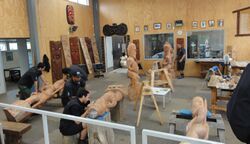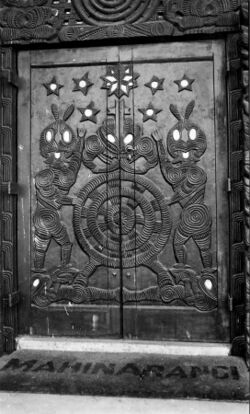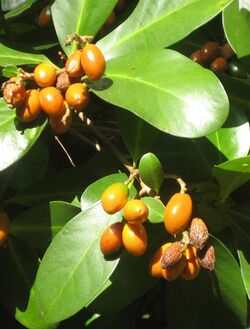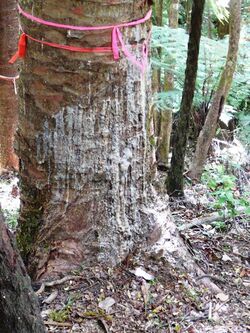Mātauranga Māori
Mātauranga (literally Māori knowledge) is a modern term for the traditional knowledge of the Māori people of New Zealand.[1][2] Māori traditional knowledge is multi-disciplinary and holistic, and there is considerable overlap between concepts. It includes environmental stewardship and economic development, with the purpose of preserving Māori culture and improving the quality of life of the Māori people over time.
The ancestors of the Māori first settled in New Zealand (Aotearoa) from other Polynesian islands in the late 13th century CE and developed a distinctive culture and knowledge-system. Mātauranga covers the entire time-period since then. Therefore, it includes oceanic navigation and other knowledge shared across the Polynesian world. Due to European colonisation, beginning in the early 19th century, much mātauranga has been lost or highly influenced by Christianity and by other aspects of foreign culture. From the 1960s, mātauranga has achieved renewed importance both in Māori and wider New Zealand culture.
Mātauranga Māori has only recently gained recognition in the scientific community for including some knowledge consistent with the scientific method; it was previously perceived by scientific institutions and researchers as entirely mythological lore, entirely superseded by modern science.[3] In the 21st century, mātauranga is often used by academics and government institutions when addressing particular environmental problems, with institutions or organisations partnering with iwi, typically with government funding.[4]
Etymology and meaning
Mātauranga Māori as a phrase became popular in the 1980s after being adopted by the New Zealand Government and in tertiary education. The term became useful in part due to the Treaty of Waitangi claims process, which included requests for the protection of traditional knowledge.[5]
Kaupapa Māori is the foundation or principles of Māori thought. It is the governing principles from which mātauranga was created. The exact relationship of the two domains is not set; however, they are distinct concepts.[6]
| Mātauranga - | sub-discipline |
|---|---|
| - huaota | botany |
| - hapori | sociology |
| - tōrangapū | political science |
| - toi | arts |
| - hanga poti | boat building, shipwright skills |
History
Mātauranga was traditionally preserved through spoken language, including songs, supplemented carving weaving, and painting, including tattoos.[10] Since colonisation, mātauranga has been preserved and shared through writing, first by non-Māori anthropologists and missionaries, then by Māori.
When mātauranga was recorded by anthropologists, the process was hampered by their preconceptions.[11] It was common practice to try to synthesis the geographic variation in mātauranga, leading to the creation of a single Māori oral history (e.g. the Great Fleet) and culture. These anthropologists informants were also sometimes paid per page for information.[citation needed]
Māori society refers to its traditional experts in healing as tohunga. Tohunga were often the only source of medicinal knowledge and education in Māori culture. In 1907, the New Zealand Parliament passed the Tohunga Suppression Act, which made tohunga practices illegal and punishable by fines or imprisonment. The Tohunga Suppression Act was finally repealed in 1962 under the Māori Community Development Act.[12] Although it caused in part the erasure of Māori knowledge and science, the legislation failed at large.[13] The New Zealand Government's intent was to inhibit traditional practices, yet some Māori people remained faithful to tohunga.[14]
Frameworks
As mātauranga stresses the connection of all knowledge, there is no single system for its division into sub-disciplines.[2] Whakapapa and the Māori language (te reo Māori ) are considered key overarching concepts. Whakapapa represents the connection between the natural and human world due to its common origin. It is commonly believed that mātauranga can be best understood in its own language and is the only way to preserve mātauranga in the future.[15]
| A strong house (Whare Tapa Wha) | The octopus (Te Wheke) | Supporting structures (Nga Pou Mana) |
|---|---|---|
| Spirituality (Wairua) | Spirituality (Wairuatanga) | Family (Whānaunga-tanga) |
| Mental health (Hinengaro) | Mental health (Hinengaro) | Cultural heritage (Taonga tuku iho) |
| Physical (Tinana) | Physical (Tinana) | Environment (Te Ao tūroa) |
| Family (Whānau) | Family (Whānaungatanga) | Land base (Turangawaewae) |
| Uniqueness (Mana ake) | ||
| Vitality (Mauri) | ||
| Cultural heritage (Ha a koro ma a kui ma) | ||
| Emotions (Whatumanawa) |
Measurement
Distance
There are two general types of distance measurement in mātauranga Māori, those based on the human body and those based on measuring stick or rope.[17] The human based measurement system included many different units, such as 'maro' which was the span of the arms outstretched horizontally. It is suspected that these systems were only of local use due to variation between people. The 'kumi' was the length of ten 'maro', this is the only recorded multiplier in mātauranga. Our evidence of the human-based system is highly reliant on the anthropologist Elsdon Best.[18]
The measuring-rod (rauru) was a way of preserving a particular human dimension. Some rauru were passed down through the generations as sacred objects and recorded the dimensions of import ancestors. Ropes were also used in measurement, particularly in the construction of building's floor plans.[17]
| Name | Length of |
|---|---|
| Pakihiwi | Shoulder to fingertips |
| Tuke | Elbow to the fingertips |
| Kōiti | Little finger |
| Kōnui | First joint of thumb |
| Ringa | Width of the hand |
| Awanui | Width of two hands (fingers closed) plus length of thumbs (outstretched with their tips touching) |
| Matikara | Span of outspread fingers from the tip of the thumb to the tip of the little finger |
Time
Mātauranga uses astronomical observations, primarily of the Sun and Moon to measure time.[19] The Moon's phases are used to define the main subdivision of the year (maramataka). The timing of the New Year varied regionally across New Zealand, but was often based around the Pleiades star cluster (Matariki). Some iwi, for example, used the first new moon after the appearance of Matariki as the start of the new year.[19] The different lunar cycles of the year and the four recognised seasons were used to plan agriculture and activities, such as fishing.[19]
The natural world
The earth mother Papatūānuku[20] and land (Whenua) is also the name for a placenta. Genealogies are often used to show the connection between natural phenomena. As example Parawhenuamea (the personification of water) married her brother Putoto. Their son Rakahore married Hinekuku (the clay maiden), their children were Tuamatua (guardian of rocks found on the sea shore) and Whatuaho (greywacke and chert) and Papakura (volcanic rocks).[21]
Rocks that had practical utility (mana) like jade (Pounamu) or Metasomatised sedimentary rock (Pakohe) were mostly sourced from rivers and the sea shore.[22] However, throughout the mountains of the South Island outcrops were also quarried.
Soil maintenance and modification was common for horticulture. This included adding gravel or sand for drainage and seaweed for fertilizer. Mātauranga concern for soil is also shown by there being more than 33 known names for different kinds.[23]
Cultivation of kūmara
By the time that European settlers arrived, Māori had large plantations of kūmara growing in many parts of New Zealand. According to Māori oral history, kūmara were not on board the original canoes that settled New Zealand, but were introduced following multiple return voyages into the Pacific.[24] Kūmara were traditionally grown as far south as Banks Peninsula. This is approximately 1,000 km further south than kūmara had been grown anywhere else in the world. The variety grown by Māori prior to the 19th century had a white skin and whitish flesh, unlike today's purple or orange-skinned varieties. The pre-European varieties grown by Māori can be left in the ground year-round in the tropics, but in the cool conditions of New Zealand, the tubers will spoil if left in cold soil over winter and spring. A wide range of techniques were developed to ensure reliable production, including careful choice of growing locations, drainage, the application of mulch and other materials to increase soil temperatures, the construction of walls to shelter the crop from the wind, and the lifting and careful storage of tubers during winter.[25]
Notable people
One notable woman was Wahakaotirangi, whose name translates to "completion from the sky".[26] As one of New Zealand's first scientists, Wahakaotirangi brought kumara to the Waikato region. When in Waikato, Wahakaotirangi built gardens in which she experimented with growing edible and medicinal plants, in particular studying how to make the kumara grow in its cooler climate. This was an essential innovation for the Tainui people of Waikato, as it provided them a reliable and sustainable source of food. Wahakaotirangi was also a part of the invention and launch of the Tainui canoe.[27]
Another notable woman was Pirongia-te-aroaro-ō-Kahu, or more commonly known as Kahupeka. Following her husband's death and her own illness, she journeyed across King Country and studied the medicinal uses of native plants such as harakeke, koromiko, kawakawa, and rangiora. Kahupeka's experiments helped the Māori people towards properly utilising hundreds of different medicinal plants.[29]
Modern practice
- Mātauranga has a strong influence on the thought of most Māori today.[2]Most traditional Māori science is now focused on a particular practical problem with science-based organisations partnering with iwi, typically with government funding. Outputs include traditional scientific publications, as well as concrete benefits for iwi. Some examples include the geothermal toxicity in food[31][32] and identifying novel antimicrobial compounds.[33]
Traditional Māori science had major impacts on pre-colonial New Zealand. For example, Wahakaotirangi's innovations in agriculture ensured the formation and survival of the Tainui people. This influence persists, and is seen in such cases as the New Zealand Department of Conservation’s Biodiversity Strategy, which states that by 2020, “traditional Māori knowledge, or mātauranga Māori, about biodiversity is respected and preserved and informs biodiversity management”.[4]
Politicisation and critique of mātauranga
Effectiveness of environmental stewardship
Archeology and quaternary geology show that New Zealand's natural environment changed significantly during the period of precolonial Māori occupation. This has led some academics to question the effectiveness of Māori traditional knowledge in managing the environment.[34][35] The environmental changes are similar to those following human occupation in other parts of the world, including deforestation (approximately 50%), the loss of the megafauna, more general species extinctions and soil degradation due to agriculture. The models favoured by academics today describe precolonial Māori as accessing resources based on ease of access and energy return. This would have involved moving from one location or food source to another when the original one had become less rewarding. Historically, academic models on precolonial environmental stewardship have been closely tied to the idea of the 'Noble Savage' and the now-debunked hypothesis of multiple ethnicities being responsible for different aspects of New Zealand's archeological record.[34][35]
Relationship to institutional science
After the Māori Renaissance, Māori academics campaigned for the creation of independent Māori Studies departments. There was a general sentiment that Māori mātauranga should be studied by Māori people, particularly in the fields of anthropology and archeology.[36] The history of traditional Māori scientific advancements is taught at a tertiary level at Victoria University of Wellington[37] and Canterbury University.[38]
Under colonisation Māori people, and women in particular, were treated as subjects rather than as creators of scientific knowledge, a treatment which continues to affect the sociological context of Māori women in science to this day.[39] Notable women in the field of traditional Māori science include Makereti Papakura, who wrote a thesis on the Māori people, and Rina Winifred Moore, the first female Māori doctor in New Zealand.[27] The Royal Society Te Apārangi also identifies 150 women and their notable contributions to New Zealand in the field of science.[40]
In 2021, The Listener published a letter titled "In Defence of Science", co-signed by several New Zealander scientists including Douglas Elliffe, Kendall Clements, Garth Cooper, Michael Corballis, Elizabeth Rata, Robert Nola, and John Werry. The letter came in response to the proposed inclusion of mātauranga Māori in the school curriculum on equal terms with "other bodies of knowledge", with the authors arguing that mātauranga Māori "falls far short of what can be defined as science itself", and disputing "the notion that science is a Western European invention and itself evidence of European dominance over Māori and other indigenous peoples."[41] The Letter sparked a controversy and calls for expulsions from the Royal Society of New Zealand, ending with Cooper and Elliffe resigning from the society in protest.[42] The authors were later supported by Richard Dawkins, who argued "New Zealand children will be taught the true wonder of DNA, while being simultaneously confused by the doctrine that all life throbs with a vital force conferred by the Earth Mother and the Sky Father".[43][44]
See also
- Māori and conservation
- Māori music
- Māori traditional textiles
- Medicinal plants
- Native American ethnobotany
- Pharmacognosy
- Listener letter on science controversy
References
- ↑ "Mātauranga Māori" (in en). https://www.sciencelearn.org.nz/topics/m%C4%81tauranga-m%C4%81ori.
- ↑ 2.0 2.1 2.2 "Indigenous Māori Values, Perspectives, and Knowledge of Soils in Aotearoa- New Zealand: Ma¯ori Use and Knowledge of Soils over Time", The Soil Underfoot (CRC Press): pp. 292–303, 2014-04-21, doi:10.1201/b16856-27, ISBN 978-0-429-18843-5, http://dx.doi.org/10.1201/b16856-27, retrieved 2021-08-03
- ↑ Hikuroa, D. (2017). "Mātauranga Māori—the ūkaipō of knowledge in New Zealand". Journal of the Royal Society of New Zealand 47 (1): 5–10. doi:10.1080/03036758.2016.1252407. https://www.tandfonline.com/doi/full/10.1080/03036758.2016.1252407?scroll=top&needAccess=true. Retrieved 9 November 2020.
- ↑ 4.0 4.1 Cram, Fiona (August 2002). Maori and Science: Three Case Studies (Report). http://www.rangahau.co.nz/assets/CramF/Cram%20Maori_science.pdf. Retrieved 12 May 2019.
- ↑ "Mätauranga Mäori and Museum Practice". Te Papa National Services te Paerangi: 1–12. 2006.
- ↑ Royal, Te Ahukaramu Charles (January 2012). "Politics and knowledge: Kaupapa Maori and matauranga Maori" (in EN). New Zealand Journal of Educational Studies 47 (2): 30–37. https://search.informit.org/doi/abs/10.3316/INFORMIT.446746674901479.
- ↑ "Mātauranga Māori | Parenting resource" (in en-GB). https://www.parentingresource.nz/supporting-information/matauranga-maori-2/.
- ↑ "Mātauranga Māori" (in en-US). https://predatorfreenz.org/toolkits/group-admininistration/matauranga-maori/.
- ↑ "Collaboration in research: weaving Kaupapa Māori and computer science". AlterNative: An International Journal of Indigenous Peoples. doi:10.1177/1177180121104316.
- ↑ "Māori weaving" (in en). 30 May 2016. https://www.tepapa.govt.nz/discover-collections/read-watch-play/maori/maori-weaving.
- ↑ Howe 2003, pp. 172–173.
- ↑ "Maori Community Development Act 1962". New Zealand Parliamentary Counsel Office (Te Tari Tohutohu Pāremata). http://www.legislation.govt.nz/act/public/1962/0133/latest/whole.html. Retrieved 9 November 2020.
- ↑ Rust, Beth. "Māori and Pacific Island women in science". https://www.tepunahamatatini.ac.nz/2018/02/12/a-story-of-some-maori-and-pacific-island-women-in-science-from-the-14th-century-to-today/. Retrieved 9 November 2020.
- ↑ Voyce, Malcolm (December 1989). "Maori Healers in New Zealand: The Tohunga Suppression Act 1907". Oceania 60 (2): 99–123. doi:10.1002/j.1834-4461.1989.tb02347.x. https://www.jstor.org/stable/40331147. Retrieved 9 November 2020.
- ↑ Reilly et al. 2018, p. 393.
- ↑ Durie, Mason (1998). Whaiora : Maori health development. Auckland, N.Z.: Oxford University Press. ISBN 0-19-558403-1. OCLC 40462575. https://www.worldcat.org/oclc/40462575.
- ↑ 17.0 17.1 17.2 "Ngā Inenga Māori: A Preliminary Study on Māori Measurement". Callaghan Innovation Report No. 0734: Measurement Standards Laboratory of New Zealand. March 2019.
- ↑ Best, Elsdon (January 1918). "The Māori system of measurement". New Zealand Journal of Science and Technology: 26–32.
- ↑ 19.0 19.1 19.2 19.3 "Early Māori measurement" (in en). https://www.sciencelearn.org.nz/resources/1856-early-maori-measurement.
- ↑ Taonga, New Zealand Ministry for Culture and Heritage Te Manatu. "Papatūānuku – the land" (in en). https://teara.govt.nz/en/papatuanuku-the-land.
- ↑ "Mātauranga Māori and science" (in en). https://www.sciencelearn.org.nz/resources/2545-matauranga-maori-and-science.
- ↑ "Pakohe–a rock that sustained early Maori society in New Zealand". http://scholar.googleusercontent.com/scholar?q=cache:7omi3VVwa1sJ:scholar.google.com/+Pakohe&hl=en&as_sdt=0,5.
- ↑ Morris, Matt (2020). Common ground : garden histories of Aotearoa. Dunedin, New Zealand. pp. 24. ISBN 978-1-988592-57-2. OCLC 1202495549. https://www.worldcat.org/oclc/1202495549.
- ↑ Crowe (2018), p187
- ↑ Crowe (2018), p189
- ↑ "Whakaotirangi". Royal Society of New Zealand Te Apārangi. https://www.royalsociety.org.nz/150th-anniversary/150-women-in-150-words/whakaotirangi/. Retrieved 10 November 2020.
- ↑ 27.0 27.1 "Maori and Pacific Island Women in Science". https://www.tepunahamatatini.ac.nz/2018/02/12/a-story-of-some-maori-and-pacific-island-women-in-science-from-the-14th-century-to-today/. Retrieved 12 May 2019.
- ↑ Taonga, New Zealand Ministry for Culture and Heritage Te Manatu. "Poisonous plants used for food" (in en). https://teara.govt.nz/en/poisonous-plants-and-fungi/page-2.
- ↑ "Kahupeka". Royal Society of New Zealand Te Apārangi. https://www.royalsociety.org.nz/150th-anniversary/150-women-in-150-words/kahupeka/. Retrieved 10 November 2020.
- ↑ "Traditional Māori medicine helps kauri health, long-term monitoring suggests" (in en). 23 September 2020. https://www.stuff.co.nz/pou-tiaki/300115269/traditional-mori-medicine-helps-kauri-health-longterm-monitoring-suggests.
- ↑ Published: 6 September 2011 (2011-09-06). "Risk assessment of contaminants in traditional food sources". NIWA. http://www.niwa.co.nz/freshwater-and-estuaries/research-projects/risk-assessment-of-contaminants-in-traditional-food-sources. Retrieved 2014-06-18.
- ↑ Last aired on Tuesday 18 September 2012 (2012-09-18). "Project Mātauranga, Series 1 Episode 6 | Māori Television". Maoritelevision.com. http://www.maoritelevision.com/tv/shows/project-matauranga/S01E006/project-matauranga-series-1-episode-6. Retrieved 2014-06-18.
- ↑ Lawrence, Scott A.; Burgess, Elaine J.; Pairama, Chris; Black, Amanda; Patrick, Wayne M.; Mitchell, Ian; Perry, Nigel B.; Gerth, Monica L. (2019-08-19). "Mātauranga-guided screening of New Zealand native plants reveals flavonoids from kānuka (Kunzea robusta) with anti-Phytophthora activity". Journal of the Royal Society of New Zealand 49: 137–154. doi:10.1080/03036758.2019.1648303. ISSN 0303-6758.
- ↑ 34.0 34.1 Howe 2003, p. 179-182.
- ↑ 35.0 35.1 Pawson & Brooking 2013, p. 35-46.
- ↑ "Anthropology and archaeology". https://teara.govt.nz/en/anthropology-and-archaeology/print.
- ↑ "Victoria University of Wellington". https://www.wgtn.ac.nz/courses/maor/202/2019/offering?crn=27089.
- ↑ "SCIM101 - Course Information System - University of Canterbury - New Zealand". Canterbury.ac.nz. http://www.canterbury.ac.nz/courseinfo/GetCourseDetails.aspx?course=SCIM101&occurrence=14S2(C)&year=2014. Retrieved 2014-06-18.
- ↑ McKinley, Elizabeth (2005). "Brown Bodies, White Coats: Postcolonialism, Maori women and science". Discourse: Studies in the Cultural Politics of Education 26 (4): 481–496. doi:10.1080/01596300500319761. https://www.tandfonline.com/doi/abs/10.1080/01596300500319761.
- ↑ "150 Women in 150 Words". Royal Society of New Zealand Te Apārangi. https://www.royalsociety.org.nz/150th-anniversary/150-women-in-150-words/. Retrieved 10 November 2020.
- ↑ Dunlop, Māni (28 July 2021). "University academics' claim that mātauranga Māori is 'not science' sparks controversy". RNZ.co.nz. Stuff. https://www.stuff.co.nz/pou-tiaki/300368356/university-academics-claim-that-mtauranga-mori-is-not-science-sparks-controversy.
- ↑ Mayron, Sapeer (13 March 2022). "Controversial 'Listener letter' deemed not worthy of Royal Society investigation". Stuff. https://www.stuff.co.nz/pou-tiaki/127919019/controversial-listener-letter-deemed-not-worthy-of-royal-society-investigation.
- ↑ Tomlinson, Hugh (1 March 2023). "Maori 'ways of knowing' are not science, says Richard Dawkins". The Times. https://www.thetimes.co.uk/article/maori-ways-of-knowing-is-not-science-says-richard-dawkins-6227grx68.
- ↑ Dawkins, Richard (4 March 2023). "Why I'm sticking up for science". The Spectator. https://www.spectator.co.uk/article/why-im-sticking-up-for-science/.
Sources
- Pawson, Eric; Brooking, Tom (2013). Making a new land : environmental histories of New Zealand (New ed.). Dunedin, New Zealand. ISBN 978-1-927322-55-0. OCLC 933761348. https://www.worldcat.org/oclc/933761348.
- Best, Elsdon (2005). Forest lore of the Māori : with methods of snaring, trapping, and preserving birds and rats, uses of berries, roots, fern-root, and forest products, with mythological notes on origins, karakia used etc.. Wellington, N.Z.: Te Papa Press. ISBN 978-1-877385-01-8. OCLC 156746436. https://www.worldcat.org/oclc/156746436.
- Best, Elsdon (1996). Tūhoe, the children of the mist : a sketch of the origin, history, myths, and beliefs of the Tūhoe tribe of the Māori of New Zealand; with some account of other early tribes of the Bay of Plenty district (4th ed.). Auckland [N.Z.]: Reed. ISBN 0-7900-0445-3. OCLC 39264131. https://www.worldcat.org/oclc/39264131.
- Crowe, Andrew (2018). Pathway of the Birds: The Voyaging Achievements of the Maori and Their Polynesian Ancestors. David Bateman Ltd. ISBN 978-1-86953-961-0.
- Howe, K (2003) (in en). The Quest for Origins - Who First Discovered and Settled New Zealand and the Pacific Islands?. Penguin Books Press. ISBN 9780143008453. OCLC 52750152.
- Reilly, Michael; Leoni, Gianna; Carter, Lyn; Duncan, Suzanne; Paterson, Lachy; Ratima, Matiu Tai (2018). Te kōparapara : an introduction to the Māori world. Auckland, New Zealand. ISBN 978-1-86940-867-1. OCLC 1031208695. https://www.worldcat.org/oclc/1031208695.
- West, Jonathan (2017). The face of nature : an environmental history of the Otago Peninsula. Dunedin, New Zealand. ISBN 978-1-927322-38-3. OCLC 994517936. https://www.worldcat.org/oclc/994517936.
External links
 |





